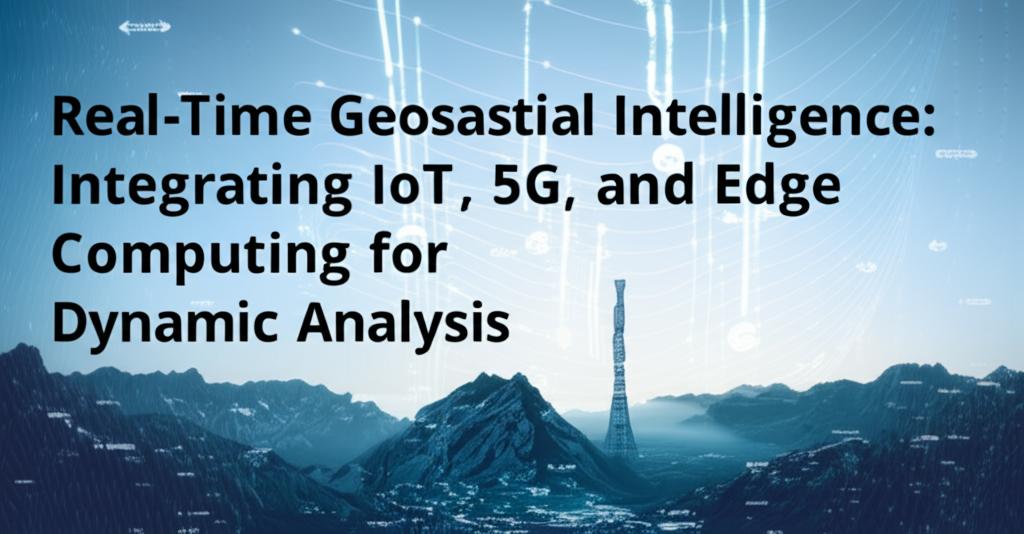The convergence of the Internet of Things (IoT), 5G technology, and edge computing is ushering in a new era of real-time geospatial intelligence, enabling dynamic analysis and rapid decision-making across a multitude of sectors. This powerful combination allows for the capture, processing, and visualization of geospatial data as it's generated, transforming how we understand and interact with our physical world.
At its core, this revolution is driven by the explosion of data from IoT devices and sensors. These devices, ranging from smart city infrastructure and environmental sensors to connected vehicles and drones, continuously generate vast streams of location-based information. 5G technology provides the essential high-bandwidth, low-latency connectivity to transmit this data reliably and efficiently. This is a significant leap from previous network generations, offering drastically improved data transfer speeds and the capacity to support a massive number of connected devices simultaneously.
However, transmitting all this data to a centralized cloud for processing can introduce delays (latency) and consume significant bandwidth. This is where edge computing becomes critical. By processing data closer to its source – at or near the "edge" of the network – organizations can significantly reduce latency, enabling faster insights and actions. Edge computing allows for real-time analysis and decision-making directly where data is collected, which is crucial for time-sensitive applications.
Key Benefits and Capabilities:- Reduced Latency for Real-Time Applications: The combination of 5G's speed and edge computing's localized processing power minimizes delays, making it ideal for applications requiring immediate responses. This is vital for autonomous vehicles, real-time traffic management, disaster response, and remote surgery.
- Enhanced Data Processing and Analysis: Edge computing, often augmented with Artificial Intelligence (AI) and Machine Learning (ML) algorithms, can perform initial data filtering, aggregation, and analysis locally. This reduces the volume of data that needs to be sent to the cloud, optimizing bandwidth usage and storage costs. AI and ML are increasingly essential for automating complex tasks like feature extraction from imagery, object detection in video feeds, and predictive analysis of spatial patterns.
- Improved Scalability and Reliability: 5G's network slicing capabilities allow for the creation of dedicated virtual networks tailored to specific application requirements, ensuring quality of service. Edge computing distributes processing tasks, reducing the load on central servers and enhancing the overall resilience of the system.
- Greater Efficiency and Cost Savings: By processing data locally, organizations can reduce data transmission costs and the need for extensive cloud infrastructure. Real-time insights also lead to more efficient operations, such as optimized routes in logistics or proactive maintenance in industrial settings.
- Support for Advanced Applications: This technological trio is a foundational enabler for emerging applications like digital twins (virtual replicas of physical assets or environments), augmented reality (AR), and virtual reality (VR) experiences that rely on precise and timely geospatial information.
The integration of IoT, 5G, and edge computing for real-time geospatial intelligence is already making a significant impact across various industries:
- Smart Cities: Optimizing urban services such as traffic flow, public transportation, waste management, and public safety through real-time monitoring and control. For instance, AI can analyze real-time and historical traffic patterns to adjust traffic signals dynamically.
- Transportation and Logistics: Enabling real-time tracking of vehicles and goods, optimizing delivery routes, supporting autonomous driving systems, and enhancing supply chain visibility.
- Environmental Monitoring: Facilitating the real-time collection and analysis of environmental data (e.g., air and water quality, deforestation, wildlife tracking) to support conservation efforts and disaster management.
- Agriculture: Supporting precision agriculture by enabling real-time monitoring of crop health, soil conditions, and weather patterns, leading to optimized resource use and increased yields.
- Manufacturing: Implementing smart factories where IoT sensors monitor equipment performance in real-time, with edge computing enabling predictive maintenance and immediate anomaly detection to prevent downtime.
- Healthcare: Supporting remote patient monitoring, real-time asset tracking within hospitals, and enabling new possibilities for remote diagnostics and even robotic surgery where low latency is paramount.
- Retail: Optimizing store layouts, managing inventory in real-time, and understanding customer behavior through location-based analytics.
- Energy and Utilities: Enabling smart grid management, real-time monitoring of pipelines and other critical infrastructure for safety and efficiency, and optimizing energy distribution.
Despite the immense potential, several challenges need to be addressed:
- Data Security and Privacy: The proliferation of IoT devices and the collection of vast amounts of geospatial data raise significant security and privacy concerns. Robust security measures, including encryption, authentication, and access control, are crucial from the edge to the cloud.
- Interoperability and Standardization: Ensuring seamless communication and data exchange between diverse IoT devices, network technologies, and edge platforms requires greater standardization and interoperability.
- Complexity of Deployment and Management: Implementing and managing distributed edge computing infrastructure alongside 5G networks and a multitude of IoT devices can be complex and require specialized expertise.
- AI Model Efficiency at the Edge: Developing lightweight and efficient AI models that can run effectively on resource-constrained edge devices without compromising accuracy is an ongoing area of research.
Looking ahead, the synergy between IoT, 5G, and edge computing will continue to evolve. We can expect advancements in AI and ML algorithms tailored for edge environments, further democratizing access to high-speed connectivity, and the development of new business models leveraging these capabilities. The journey from static maps to "live maps" – dynamic, responsive representations of the world reflecting real-time changes – is well underway, promising a future where geospatial intelligence is more immediate, actionable, and integral to an ever-increasing range of applications. This hyper-connected ecosystem will drive innovation, enhance operational efficiency, and unlock new opportunities for dynamic analysis and intelligent decision-making.

